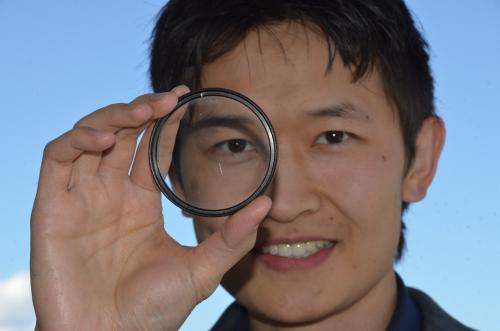Engineers pioneer flat spray-on optical lens

A team of researchers, including a University of British Columbia engineer have made a breakthrough utilizing spray-on technology that could revolutionize the way optical lenses are made and used.
Kenneth Chau, an assistant professor in the School of Engineering at UBC's Okanagan campus, worked with principal investigator Henri Lezec and colleagues Ting Xu, Amit Agrawal, and Maxim Abashin at the National Institute of Standards and Technology (NIST) in Maryland on the development of a flat lens. Their work is published in the May 23 issue of the journal Nature, and is summarized in an online feature released by NIST.
Nearly all lenses – whether in an eye, a camera, or a microscope – are presently curved, which limits the aperture, or amount of light that enters.
"The idea of a flat lens goes way back to the 1960s when a Russian physicist came up with the theory," Chau says. "The challenge is that there are no naturally occurring materials to make that type of flat lens. Through trial and error, and years of research, we have come up with a fairly simple recipe for a spray-on material that can act as that flat lens."
The research team has developed a substance that can be affixed to surfaces like a glass slide and turn them into flat lenses for ultraviolet light imaging of biological specimens.
"Curved lenses always have a limited aperture," he explains. "With a flat lens, suddenly you can make lenses with an arbitrary aperture size – perhaps as big as a football field."
While the spray-on, flat lens represents a significant advancement in technology, it is only an important first step, Chau says.
"This is the closest validation we have of the original flat lens theory," he says. "The recipe, now that we've got it working, is simple and cost-effective. Our next step is to extrapolate this technique further, explore the effect to the fullest, and advance it as far as we can take it."
The technology could change the way imaging devices like cameras and scanners are designed.
More information: All-angle negative refraction and active flat lensing of ultraviolet light, Nature, 2013.
Journal information: Nature
Provided by University of British Columbia


















